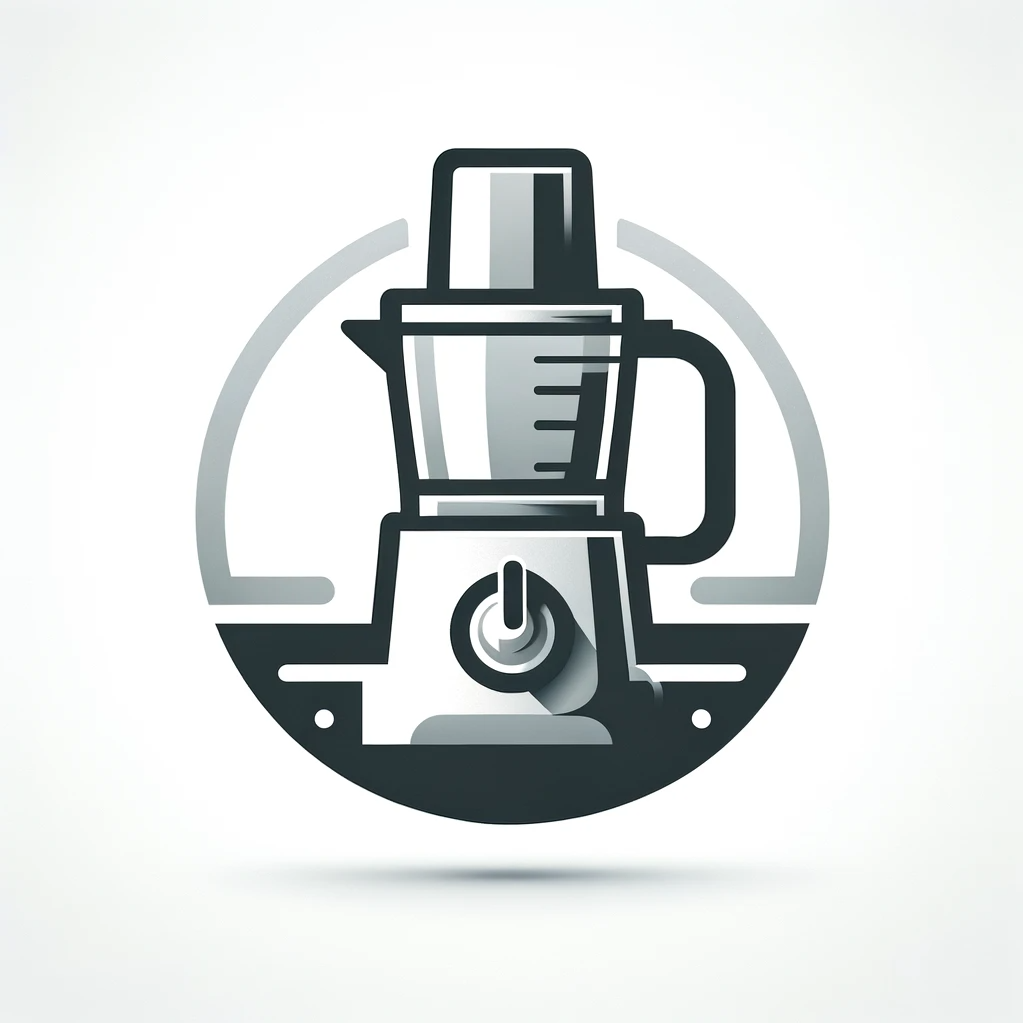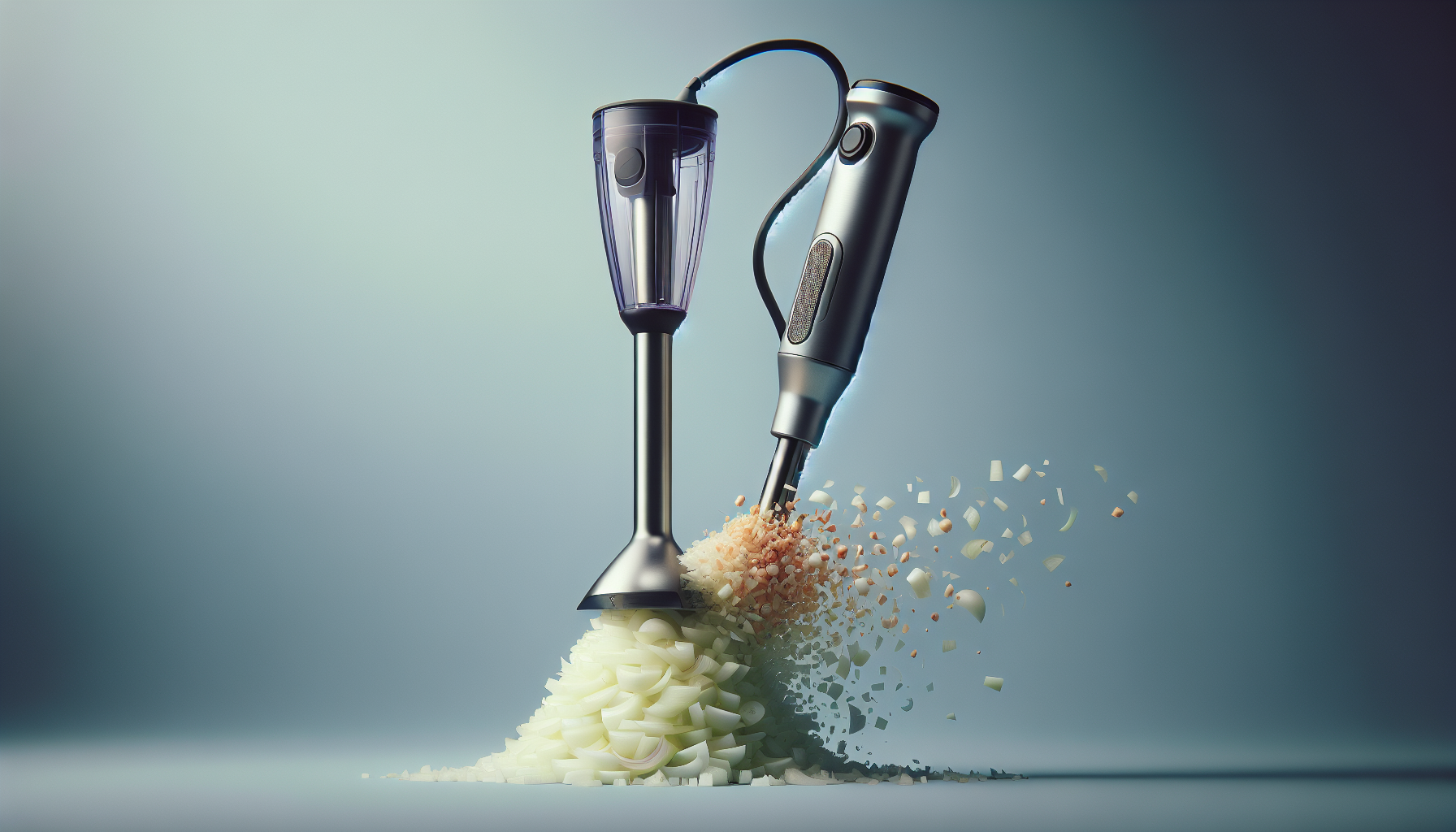Imagine effortlessly chopping onions with just a stick blender wielded in your hand. Sounds too good to be true, right? Well, the question remains: can you actually use a stick blender to chop onions? In this article, we will explore whether this handy kitchen gadget is up to the task of transforming pungent bulbs into fine, evenly diced pieces. Prepare to be surprised as we unveil the truth behind the stick blender’s onion-chopping capabilities.
CHECK OUT FOOD PROCESSORS AND VEGETABLE CHOPPERS ON AMAZON
The Advantages of Using a Stick Blender
Versatility
When it comes to kitchen appliances, versatility is key. A stick blender, also known as an immersion blender, offers a wide range of uses beyond simply chopping onions. With various attachments and speed options, you can effortlessly blend soups, puree sauces, whip cream, and even make smoothies. This makes a stick blender a versatile tool that can take on multiple tasks in the kitchen, helping you save time and effort.
Convenience and Time-saving
One of the major advantages of using a stick blender is its convenience and time-saving nature. Unlike traditional blenders or food processors, a stick blender allows you to blend ingredients directly in the pot or container. This eliminates the need for transferring batches of ingredients back and forth, saving you both time and hassle. Whether you’re making a quick soup or a delicious sauce, a stick blender ensures a seamless and efficient cooking experience.
Easy to Use and Clean
Another great advantage of stick blenders is their ease of use and cleaning. Unlike bulky countertop blenders, stick blenders are lightweight and easy to handle. Simply immerse the blending wand into your ingredients, press the power button, and blend away. Additionally, cleaning a stick blender is a breeze. Most models have detachable blending wands and attachments that can be easily rinsed or washed in the sink or dishwasher. This means less time spent on clean-up and more time enjoying your culinary creations.
CHECK OUT FOOD PROCESSORS AND VEGETABLE CHOPPERS ON AMAZON
Understanding Stick Blenders
Definition and Function
A stick blender, or immersion blender, is a handheld kitchen appliance used for blending, mixing, and pureeing ingredients. Its design consists of a long, slender wand with blades at the end, which are immersed directly into the food or liquid being blended. With its powerful motor and rotating blades, a stick blender quickly and effectively blends ingredients together, creating smooth textures and consistent results.
Components and Attachments
Stick blenders typically consist of several components, including the motor housing, control buttons, and a detachable blending wand. These wands may come in various lengths and are typically made of stainless steel or other durable materials. Additionally, stick blenders often come with attachments such as a whisk attachment for whisking cream or eggs, a chopper attachment for chopping nuts or herbs, and a blending cup for soups or sauces.
Types of Stick Blenders
There are several types of stick blenders available on the market, each with its own features and capabilities. Corded stick blenders are powered by an electrical cord and offer constant, uninterrupted power. Alternatively, cordless stick blenders are battery-operated, providing mobility and flexibility in the kitchen. Some stick blenders also have variable speed options, allowing you to control the blending speed based on your specific needs.
Chopping Onions with a Stick Blender
Suitability for Chopping Onions
While stick blenders are great for various kitchen tasks, using them specifically for chopping onions may not always be the best option. The flexibility and design of a stick blender are better suited for blending and pureeing ingredients rather than achieving precise chopping results. However, stick blenders can still be used to achieve coarse or semi-coarse results when chopping onions.
Efficiency and Time-saving
When it comes to chopping onions, using a stick blender can be an efficient and time-saving method. With its powerful motor and blades, a stick blender can quickly break down onions into small pieces. This can be especially beneficial when you’re in a hurry or need to chop a large quantity of onions for a recipe. The speed and effectiveness of a stick blender can help you get the job done in no time.
Consistency and Texture of Chopped Onions
While stick blenders can efficiently chop onions, it’s important to note that the consistency and texture of the chopped onions may not be as uniform compared to hand chopping or other methods. The blades of a stick blender tend to create a slightly more pulpy or blended texture, which may not be desirable for certain dishes. If you prefer finely diced onions or need a specific texture for your recipe, a stick blender may not be the ideal tool.
Proper Technique to Chop Onions with a Stick Blender
Preparation of Onions
Before using a stick blender to chop onions, it’s important to prepare them properly. Start by peeling the skin off the onions and cutting them into quarters. This will help the stick blender blend the onions more efficiently.
Using the Correct Attachment
To chop onions with a stick blender, it’s crucial to use the correct attachment. Most stick blenders come with a chopper attachment specifically designed for chopping ingredients. Attach the chopper attachment to the blending wand securely before proceeding.
Blending Technique
To chop onions with a stick blender, simply immerse the blending wand with the chopper attachment into the prepared onions. Hold the stick blender at a slight angle and pulse the power button to start blending. Move the stick blender around the onions, ensuring that all pieces are evenly chopped. Be cautious not to overblend, as this can lead to a pureed texture rather than chopped onions.
Potential Drawbacks of Using a Stick Blender for Onions
Loss of Control
One potential drawback of using a stick blender for chopping onions is the loss of control. Unlike hand chopping with a knife, stick blenders offer less precision and control, potentially resulting in uneven chopping or unwanted textures. It’s important to be mindful of the blending time and technique to avoid overblending or ending up with inconsistent results.
Uneven Chopping
Due to the design and blades of stick blenders, achieving perfectly even chopping results can be challenging. The rotating blades of a stick blender tend to create a pulpy or blended texture, which may not be desirable for certain recipes. If uniformity is crucial for your dish, consider using alternative methods such as hand chopping or using a food processor.
Cleaning and Maintenance
Stick blenders, particularly those with detachable components, require regular cleaning and maintenance. The blades and attachments can accumulate food residue, making it necessary to disassemble and clean them thoroughly after each use. While this may not be a major drawback, it’s important to consider the additional time and effort required for cleaning and maintenance.
Alternatives to a Stick Blender for Chopping Onions
Hand Chopping
The most traditional method for chopping onions is by hand using a knife and cutting board. This method offers the highest level of control and allows you to achieve precise chopping results based on your preference. Hand chopping can be time-consuming, but the results are often more consistent in texture and size compared to using a stick blender.
Food Processors
Food processors are another popular kitchen appliance for chopping onions and various other ingredients. Equipped with sharp blades and a powerful motor, food processors can quickly and efficiently chop onions into desired sizes or even achieve fine dices. However, food processors are often bulkier and require more counter space. They also involve more assembly and clean-up compared to stick blenders.
Mini Choppers
For those who want to simplify the onion chopping process, mini choppers are a convenient alternative. These small electric devices are designed specifically for chopping ingredients, including onions, in a quick and hassle-free manner. While they may not offer the same versatility as stick blenders or food processors, mini choppers are compact, easy to use, and require minimal clean-up.
Tips for Using a Stick Blender Efficiently
Choosing the Right Speed
When using a stick blender, it’s important to choose the right speed for the task at hand. Higher speeds are suitable for blending and pureeing ingredients, while lower speeds are better for chopping and dicing. Adjusting the speed according to your desired results will help you achieve better control and consistency.
Avoid Overfilling the Blender Cup
Stick blenders often come with blending cups or containers for convenience. When blending onions or any other ingredients, avoid overfilling the cup. Overfilling can lead to uneven blending and spillage, causing a mess. It’s best to blend in smaller batches, ensuring that the ingredients are evenly chopped and blended.
Consider Blending in Batches
If you’re using a stick blender to chop a large quantity of onions, consider blending them in batches. This will prevent overloading the blender and ensure that the onions are consistently chopped. By blending in smaller batches, you’ll also have better control over the blending process, resulting in more uniform results.
Cleaning and Maintenance of Stick Blenders
Detaching and Cleaning Attachments
Stick blenders typically have detachable blending wands and attachments, making them easy to clean. After each use, detach the blending wand and attachments from the motor housing. Rinse them under warm water and use a mild dish soap to remove any food residues. For stubborn residues, a gentle brush can be used. Ensure that all components are thoroughly dry before reassembling or storing.
Removing Food Residue
To remove any food residue stuck on the motor housing or buttons, use a damp cloth or sponge. Avoid submerging the motor housing in water. Wipe it clean, taking extra care around the buttons and power cord. Regular cleaning will help maintain the performance and longevity of your stick blender.
Storing the Stick Blender
To prolong the lifespan of your stick blender, proper storage is essential. Store the stick blender in a dry and clean location, away from direct heat or sunlight. Ensure that all attachments are securely attached or stored separately to prevent damage or loss. Consider investing in a storage case or container specifically designed for stick blenders to keep all components organized and protected.
Key Factors to Consider when Buying a Stick Blender
Power and Speed Options
When purchasing a stick blender, consider the power and speed options offered by the model. Higher wattage or power ensures more efficient blending, while multiple speed options allow for versatile use. Look for a stick blender that offers a range of speeds to accommodate different tasks and ingredients.
Quality of Construction
The quality of construction plays a significant role in the performance and durability of a stick blender. Opt for a model made of sturdy materials, such as stainless steel or durable plastic. Check for reviews or ratings to ensure that the stick blender is built to last and can withstand regular use.
Additional Attachments and Features
Consider the additional attachments and features that come with the stick blender. Whisk attachments, chopper attachments, or blending cups can enhance the versatility and functionality of the blender. Look for models that offer these extras if you need them for specific recipes or tasks.
Conclusion
In conclusion, stick blenders offer a variety of advantages when it comes to versatility, convenience, and ease of use in the kitchen. While they may not be the optimal tool for chopping onions due to potential drawbacks such as loss of control and uneven chopping, stick blenders excel in blending and pureeing tasks. Understanding the proper technique and considering alternative methods for chopping onions can help you make an informed decision. Whether you choose to use a stick blender or explore other options, the key is to find a method that suits your preferences and cooking needs.

